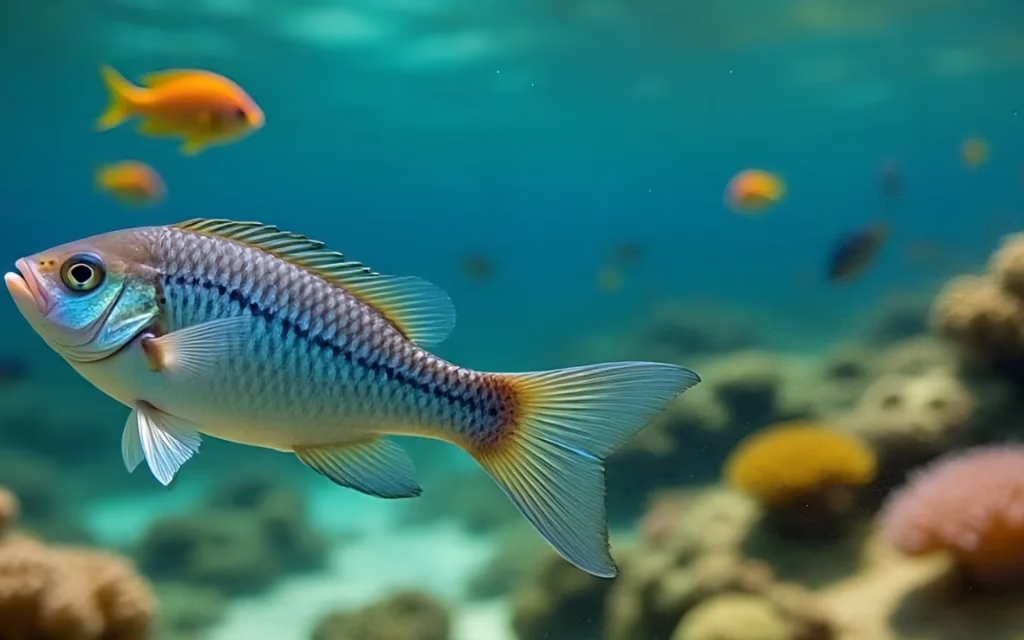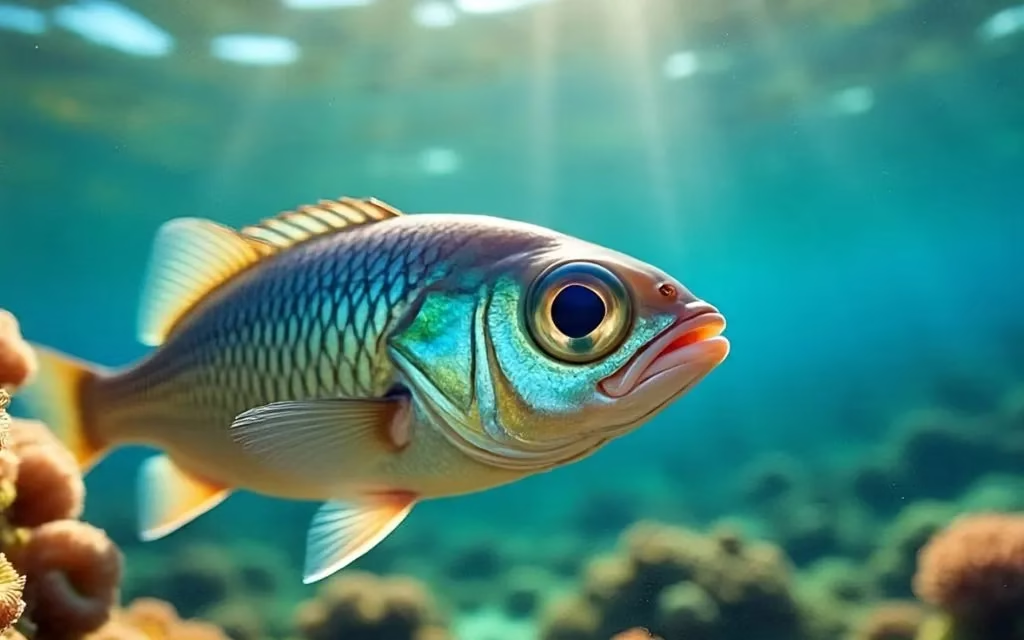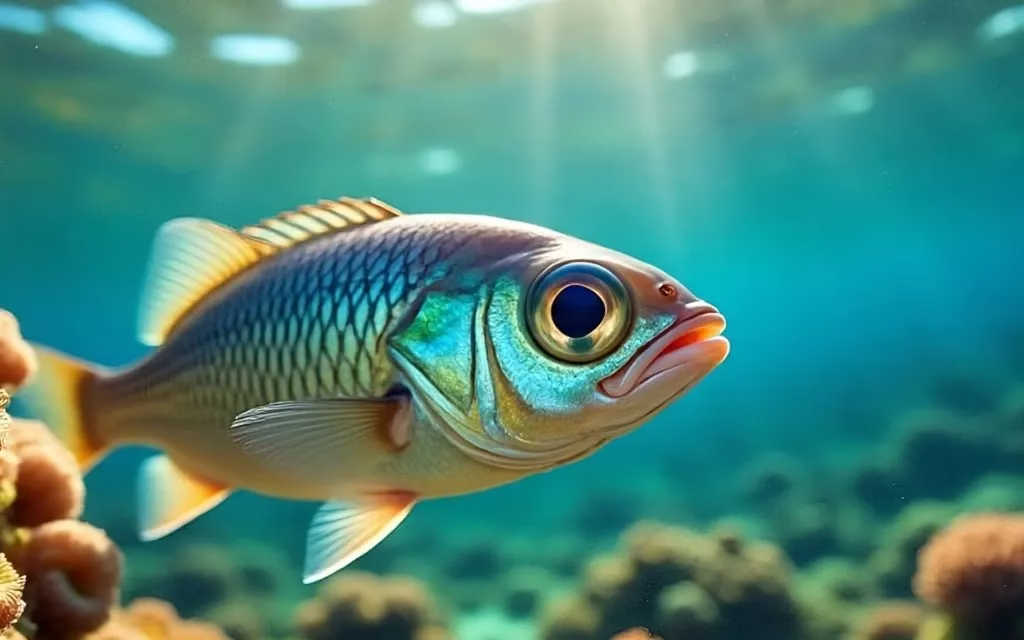How fish see what’s around them is one of the most amazing things about the undersea world. Fish eyes are very different from human eyes, which helps them stay alive, hunt, and find their way around underwater.They need their eyesight to stay alive, whether they live in the ocean or in freshwater. We can learn more about life in the ocean by studying how fish eyes work.This is also helpful for people who study marine biology and eye care.
Structure of Fish Eyes
At first glance, fish eyes and human eyes may look the same, yet they are very different. When people look at objects, the lens in their eyes changes shape. When fish look at things, the lens is more spherical and slides back and forth inside the eye to focus. Because of this circular shape, fish can see well underwater. Light behaves differently in water than it does in the air.The cornea is also different because of its size. Because the cornea in has a refractive index that is near to that of water, it doesn’t do much to focus light. But the lens performs most of the work. This change helps fish find food.

How Fish Eyes Adapt to Underwater Vision
One of the coolest things about fish eyes is that they can see in the dark.In murky water or the deep sea, there isn’t much light, thus certain fish have evolved huge eyes that are particularly sensitive to light so they can see as much as they can.The tapetum lucidum is a reflective layer that some people have under their retina. This layer helps them see better at night by reflecting light back through the cells that receive light.Some fish that live in shallow water may see more colors than other fish.They can identify colors apart better, which helps them find food, mates, and places to hide.Deep-sea fish.
Fish Eyes and Color Vision
Fish eyes can see a wider range of colors than human eyes.The majority of individuals possess three types of cone cells capable of perceiving red, green, and blue light. But certain types of fish have more cone cells that enable them see UV light.This means that they can see things that people can’t.Some reef fish, for example, have markings that can only be seen with UV light. This offers them a secret color language. These unique modifications of fish eyes assist in their survival and facilitate communication and reproduction.
Comparing Fish Eyes and Human Eyes
At first glance, fish eyes may look like ours, but there are huge differences.The cornea is particularly crucial for focusing in human eyes, and the spherical lens is very vital for focusing in fish eyes. People can quickly focus on items that are close by or far away, whereas fish change the shape of their lenses instead of shifting them.People have eyelids and tears to keep their eyes safe and moist. Fish don’t have eyelids, and their eyes are always in water, which keeps them wet. Their eyes are always ready to see things immediately away since they are always open, while humans sometimes blink to adjust.
Evolutionary Role of Fish Eyes
The story of how fish eyes came to be is really interesting. It is thought that eyes initially appeared some 500 million years ago, and fish were among the earliest animals to develop complex eyes. The structure of their eyes has influenced the evolution of vision in various creatures, including amphibians, reptiles, birds, and mammals.The alterations in fish eyes highlight how nature adjusts how we see things to match the needs of the environment. Fish have evolved eyes that are perfect for their habitats, from coral reefs that are shallow and bright to the deep ocean where it is dark.
Fish Eyes in Different Habitats
Fish eyes act differently depending on the water they reside in. In lakes and rivers with fresh water, sediments and plants can make it harder to see. Fish that live here usually have bigger eyes or more rod cells that let them see movement in the dark.But reef fish often use color vision.Their fish eyes are better at seeing vivid colors, which helps them discover food and mates in a colorful world. Lanternfish and other fish that live deep in the ocean have extraordinarily wide eyes that allow them notice even the tiniest flashes of light.

Special Adaptations of Fish Eyes
Some animals have particularly unique eyes that help them see. The four-eyed fish, Anableps, has eyes that are split in half. This helps it see both above and below the water at the same time. Fish have a specific method of seeing that helps them find food without being observed by predators.Flatfish have another interesting adaptation. As the fish matures, one eye shifts to the other side of its body, so both eyes are on the same side. This strange but useful change enables them lie flat on the ocean floor and still observe what’s going on around them.
Fish Eyes and Scientific Research
By looking at fish eyes, scientists have discovered new things about biology and optics. Scientists study how fish see underwater to improve cameras that work underwater and even better ways to cure human eyes. Fish eyes are useful for studying how eyes respond to different levels of light since they are built to live in tough places.Genetic research has shown that the genes that control vision in fish eyes are similar to those that control vision in humans. By investigating visual impairments, scientists learn more about them and how to treat them.
Myths and Cultural Beliefs About Fish Eyes
Throughout history, several societies have given fish eyes symbolic meaning. Some societies thought that they would keep evil things from happening to them.People in some Asian cultures think that fish eyes are a delicacy and that they are excellent for your atmosphere.In stories, the appearance of fish eyes often meant wisdom or different , demonstrating how deep the water is. These cultural ties show that humans have been interested in how fish sees for a long time because of how unique they look and how they work.
Role of Fish Eyes in Communication
Fish don’t use sound as much as creatures that live on place do, but their eyesight is a big part of how they speaking to each other. Fish let them see minute changes in color, body size , and patterns.For instance, male fish often show off bright colors when they are meeting, and female fish use their excellent eyesight to pick the best mate.In schools of fish, synchronized driving is very dependent on what you can see. Fish have exceptionally good eyesight, which helps them stay in line and safe when they are among other fish.
Common Problems Affecting Fish Eyes
Just like us, fish can have struggles with their eyes. Fish in aquariums often have clouded eyes, Fish eyes that stick out, or diseases. Bad water quality, injuries, or bacterial infections could be to blame for these issues.Aquarists and marine biologists can fix and stop these kinds of difficulties by studying how fish see.It’s crucial to keep the water clean, give the fish the correct meals, and search for signs of sickness early on to keep them healthy. It’s crucial to take proper care of fish eyes because they are quite fragile.
Conclusion
Their eyes are one of the most remarkable features about aquatic animals. The way they are built, how they adapt, and how they help them stay alive indicate how hard life is underwater. Fish eyes are a good example of how evolution can be different. They can see in low light, pick up ultraviolet patterns, or converse to one other through colors. We learn about marine life and how lovely it is by studying it. This helps us discover things that are helpful for people too.




